A Cloud Top-Height Retrieval Algorithm Using Simultaneous Observations from the Himawari-8 and FY-2E Satellites
Abstract
:1. Introduction
2. Datasets
2.1. Input Datasets of the Algorithm
2.1.1. Himawari-8
2.1.2. FengYun 2E (FY-2E)
2.2. Inter-Comparison Datasets
2.2.1. Cloud-Aerosol Lidar and Infrared Pathfinder Satellite Observation/Cloud-Aerosol Lidar with Orthogonal Polarization (CALIPSO/CALIOP)
2.2.2. CloudSat/Cloud-Profiling Radar (CPR)
2.2.3. Himawari-8/Advanced Himawari Imager (AHI)
3. Description of Algorithm
3.1. Image Remapping
3.2. Image Matching
3.3. Cloud-Top Height (CTH) Calculation
3.4. Quality Control
4. Retrieval Results and Inter-Comparisons
4.1. Case Study 1: 8 November 2017
4.2. Case Study 2: 21 September 2017
4.3. Case Study 3: 3 November 2017
5. Discussion
5.1. Characteristics of the Dual-Geostationary (GEO) CTH Algorithm: Advantages and Limitations
5.2. Theoretical Accuracy and Comparison of the Dual-GEO CTH Algorithm
5.3. Theoretical Accuracies of Other Satellite Combinations in East Asia
6. Summary and Conclusions
Author Contributions
Funding
Acknowledgments
Conflicts of Interest
References
- Salby, M.L. Physics of the Atmosphere and Climate, 2nd ed.; Cambridge University Press: New York, NY, USA, 2012; p. 666. [Google Scholar]
- Weisz, E.; Li, J.; Menzel, W.P.; Heidinger, A.K.; Kahn, B.H.; Liu, C.-Y. Comparison of AIRS, MODIS, CloudSat and CALIPSO cloud top height retrievals. Geophys. Res. Lett. 2007, 34, L17811. [Google Scholar] [CrossRef]
- Hamann, U.; Walther, A.; Baum, B.; Bennartz, R.; Bugliaro, L.; Derrien, M.; Francis, P.N.; Heidinger, A.; Joro, S.; Kniffka, A.; et al. Remote sensing of cloud top pressure/height from SEVIRI: Analysis of ten current retrieval algorithms. Atmos. Meas. Tech. 2014, 7, 2839–2867. [Google Scholar] [CrossRef] [Green Version]
- Chung, C.-Y.; Francis, P.N.; Saunders, R.W.; Kim, J. Comparison of SEVIRI-derived cloud occurrence frequency and cloud-top height with A-train data. Remote Sens. 2017, 9, 24. [Google Scholar] [CrossRef] [Green Version]
- Menzel, W.P.; Wylie, D.P.; Strabala, K.I. Seasonal and diurnal changes in cirrus clouds as seen in four years of observations with the VAS. J. Appl. Meteor. 1992, 31, 370–385. [Google Scholar] [CrossRef] [Green Version]
- Wylie, D.P.; Santek, D.; Starr, D.O.C. Cloud-top heights from GOES-8 and GOES-9 stereoscopic imagery. J. Appl. Meteor. 1998, 37, 405–413. [Google Scholar] [CrossRef]
- Wylie, D.P.; Menzel, W.P. Two years of cloud cover statistics using VAS. J. Clim. 1989, 2, 380–392. [Google Scholar] [CrossRef] [Green Version]
- Menzel, W.P.; Frey, R.A.; Zhang, H.; Wylie, D.P.; Moeller, C.C.; Holz, R.E.; Maddux, B.; Baum, B.A.; Strabala, K.I.; Gumley, L.E. MODIS global cloud-top pressure and amount estimation: Algorithm description and results. J. Appl. Meteorol. Clim. 2008, 47, 1175–1198. [Google Scholar] [CrossRef] [Green Version]
- Wielicki, B.A.; Coakley, J.A. Cloud retrieval using infrared sounder data: Error analysis. J. Appl. Meteorol. 1981, 20, 157–169. [Google Scholar] [CrossRef] [Green Version]
- Stephens, G.L.; Vane, D.G.; Boain, R.J.; Mace, G.G.; Sassen, K.; Wang, Z.; Illingworth, A.J.; O’Connor, E.J.; Rossow, W.B.; Durden, S.L.; et al. The Cloudsat mission and the A-train: A new dimension of space-based observations of clouds and precipitation. Bull. Am. Meteorol. Soc. 2002, 83, 1771–1790. [Google Scholar] [CrossRef] [Green Version]
- Hasler, A.F. Stereographic observations from geosynchronous satellites: An important new tool for the atmospheric sciences. Bull. Am. Meteorol. Soc. 1981, 62, 194–212. [Google Scholar] [CrossRef] [Green Version]
- Seiz, G.; Tjemkes, S.; Watts, P. Multiview cloud-top height and wind retrieval with photogrammetric methods: Application to Meteosat-8 HRV observations. J. Appl. Meteorol. Clim. 2007, 46, 1182–1195. [Google Scholar] [CrossRef] [Green Version]
- Zakšek, K.; Hort, M.; Zaletelj, J.; Langmann, B. Monitoring volcanic ash cloud top height through simultaneous retrieval of optical data from polar orbiting and geostationary satellites. Atmos. Chem. Phys. 2013, 13, 2589–2606. [Google Scholar] [CrossRef] [Green Version]
- Merucci, L.; Zakšek, K.; Carboni, E.; Corradini, S. Stereoscopic estimation of volcanic ash cloud-top height from two geostationary satellites. Remote Sens. 2016, 8, 206. [Google Scholar] [CrossRef] [Green Version]
- Corradini, S.; Montopoli, M.; Guerrieri, L.; Ricci, M.; Scollo, S.; Merucci, L.; Marzano, F.S.; Pugnaghi, S.; Prestifilippo, M.; Ventress, L.J.; et al. A multi-sensor approach for volcanic ash cloud retrieval and eruption characterization: The 23 November 2013 Etna lava fountain. Remote Sens. 2016, 8, 58. [Google Scholar] [CrossRef] [Green Version]
- Bessho, K.; Date, K.; Hayashi, M.; Ikeda, A.; Imai, T.; Inoue, H.; Kumagai, Y.; Miyakawa, T.; Murata, H.; Ohno, T.; et al. An introduction to Himawari-8/9-Japan’s new-generation geostationary meteorological satellites. J. Meteorol. Soc. Jpn. 2016, 94, 151–183. [Google Scholar] [CrossRef] [Green Version]
- Okamoto, K. Evaluation of IR radiance simulation for all-sky assimilation of Himawari-8/AHI in a mesoscale NWP system. Q. J. R. Meteor. Soc. 2017, 143, 1517–1527. [Google Scholar] [CrossRef]
- Jin, X.; Wu, T.; Li, L.; Shi, C. Cloudiness characteristics over Southeast Asia from satellite FY-2C and their comparison to three other cloud data sets. J. Geophys. Res. 2009, 114. [Google Scholar] [CrossRef] [Green Version]
- Winker, D.M.; Vaughan, M.A.; Omar, A.; Hu, Y.; Powell, K.A.; Liu, Z.; Hunt, W.H.; Young, S.A. Overview of the CALIPSO mission and CALIOP data processing algorithms. J. Atmos. Ocean. Technol. 2009, 26, 2310–2323. [Google Scholar] [CrossRef]
- Hunt, W.H.; Winker, D.M.; Vaughan, M.A.; Powell, K.A.; Lucker, P.L.; Weimer, C. CALIPSO lidar description and performance assessment. J. Atmos. Ocean. Technol. 2009, 26, 1214–1228. [Google Scholar] [CrossRef]
- Kim, S.-W.; Chung, E.-S.; Yoon, S.-C.; Sohn, B.-J.; Sugimoto, N. Intercomparisons of cloud-top and cloud-base heights from ground-based lidar, CloudSat and CALIPSO measurements. Int. J. Remote. Sens. 2011, 32, 1179–1197. [Google Scholar] [CrossRef]
- Im, E.; Wu, C.; Durden, S.L. Cloud profiling radar for the CloudSat mission. IEEE. Aerosp. Electron. Syst. Mag. 2005, 20, 15–18. [Google Scholar] [CrossRef]
- Stephens, G.L.; Vane, D.G.; Tanelli, S.; Im, E.; Durden, S.; Rokey, M.; Reinke, D.; Partain, P.; Mace, G.G.; Austin, R.; et al. CloudSat mission: Performance and early science after the first year of operation. J. Geophys. Res. 2008, 113. [Google Scholar] [CrossRef]
- Mace, G. Level 2 GEOPROF Product Process Description and Interface Control Document Algorithm; Version 5.3; NASA Jet Propulsion Laboratory: La Cañada Flintridge, CA, USA, 2007. [Google Scholar]
- Nakajima, T.Y.; Nakajima, T. Wide-area determination of cloud microphysical properties from NOAA AVHRR measurements for FIRE and ASTEX regions. J. Atmos. Sci. 1995, 52, 4043–4059. [Google Scholar] [CrossRef] [Green Version]
- Letu, H.; Nagao, T.M.; Nakajima, T.Y.; Riedi, J.; Ishimoto, H.; Baran, A.J.; Shang, H.; Sekiguchi, M.; Kikuchi, M. Ice cloud properties from Himawari-8/AHI next-generation geostationary satellite: Capability of the AHI to monitor the DC cloud generation process. IEEE. Trans. Geosci. Remote 2019, 57, 3229–3239. [Google Scholar] [CrossRef]
- Letu, H.; Yang, K.; Nakajima, T.Y.; Ishimoto, H.; Nagao, T.M.; Riedi, J.; Baran, A.J.; Ma, R.; Wang, T.; Shang, H.; et al. High-resolution retrieval of cloud microphysical properties and surface solar radiation using Himawari-8/AHI next-generation geostationary satellite. Remote Sens. Environ. 2020, 239, 111583. [Google Scholar] [CrossRef]
- Zhao, F.; Huang, Q.; Gao, W. Image matching by normalized cross-correlation. In Proceedings of the IEEE International Conference on Acoustics Speech and Signal Processing (ICASSP), Toulouse, France, 14–19 May 2006. [Google Scholar]
- Yoo, J.-C.; Han, T.H. Fast normalized cross-correlation. Circuits Syst. Signal Process. 2009, 28, 819–843. [Google Scholar] [CrossRef]
- Aqel, M.O.A.; Marhaban, M.H.; Saripan, M.I.; Ismail, N.B. Adaptive-search template matching technique based on vehicle acceleration for monocular visual odometry system. IEEJ. Trans. Electr. Electron. 2016, 11, 739–752. [Google Scholar] [CrossRef]
- Hasler, A.F.; Strong, J.; Woodward, R.H.; Pierce, H. Automatic-analysis of stereoscopic satellite image pairs for determination of cloud-top height and structure. J. Appl. Meteorol. 1991, 30, 257–281. [Google Scholar] [CrossRef] [Green Version]
- Zakšek, K.; Gerst, A.; von der Lieth, J.; Ganci, G.; Hort, M. Cloud photogrammetry from space. In Proceedings of the International Archives of the Photogrammetry Remote Sensing and Spatial Information Science, Berlin, Germany, 11–15 May 2015. [Google Scholar]
- Prata, A.J.; Turner, P.J. Cloud-top height determination using ATSR data. Remote. Sens. Environ. 1997, 59, 1–13. [Google Scholar] [CrossRef]
- Huang, Y.; Siems, S.; Manton, M.; Protat, A.; Majewski, L.; Nguyen, H. Evaluating Himawari-8 cloud products using shipborne and CALIPSO observations: Cloud-top height and cloud-top temperature. J. Atmos. Ocean. Technol. 2019, 36, 2327–2347. [Google Scholar] [CrossRef] [Green Version]
- Virtanen, T.H.; Kolmonen, P.; Rodríguez, E.; Sogacheva, L.; Sundström, A.-M.; de Leeuw, G. Ash plume top height estimation using AATSR. Atmos. Meas. Technol. 2014, 7, 2437–2456. [Google Scholar] [CrossRef] [Green Version]

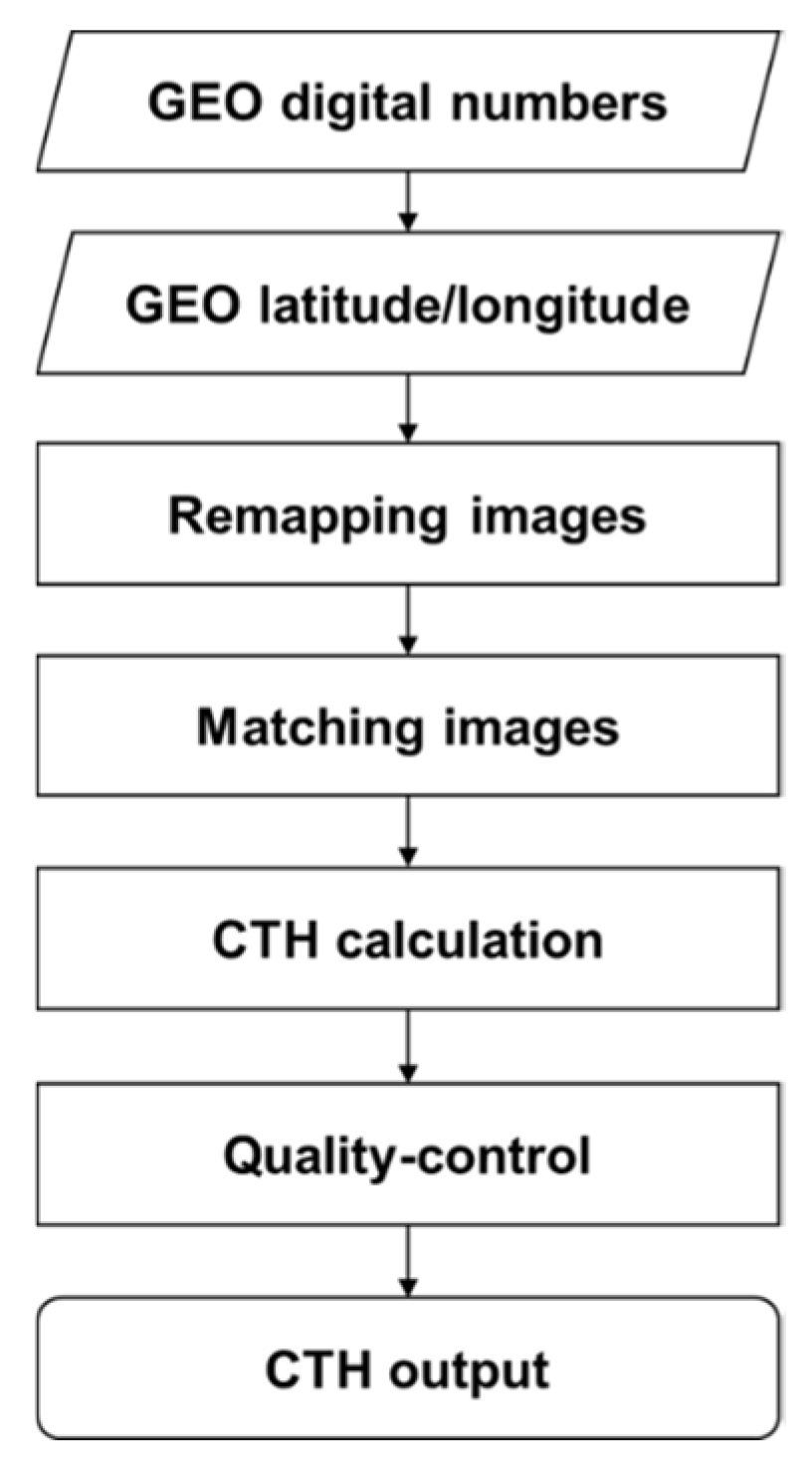



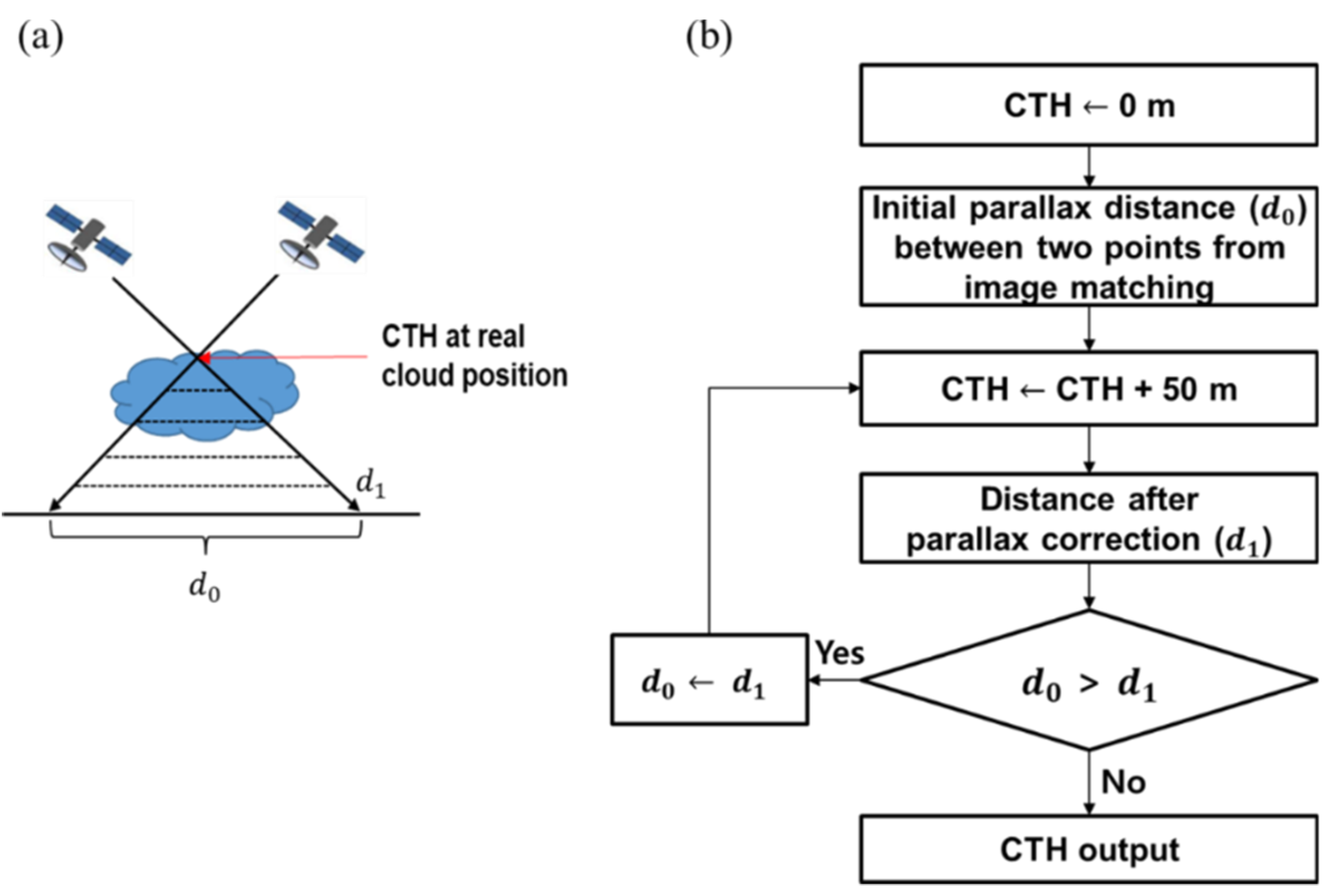
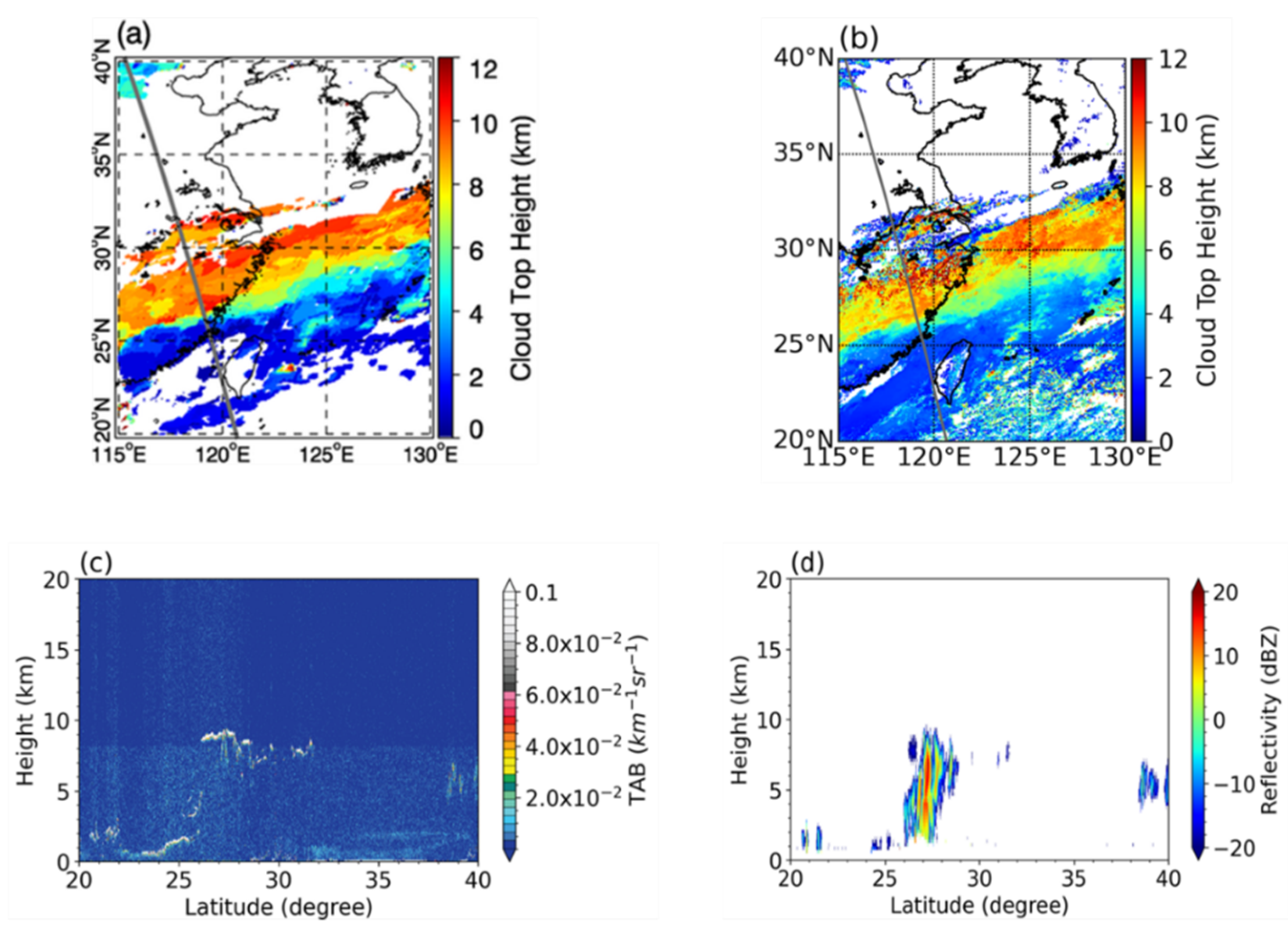



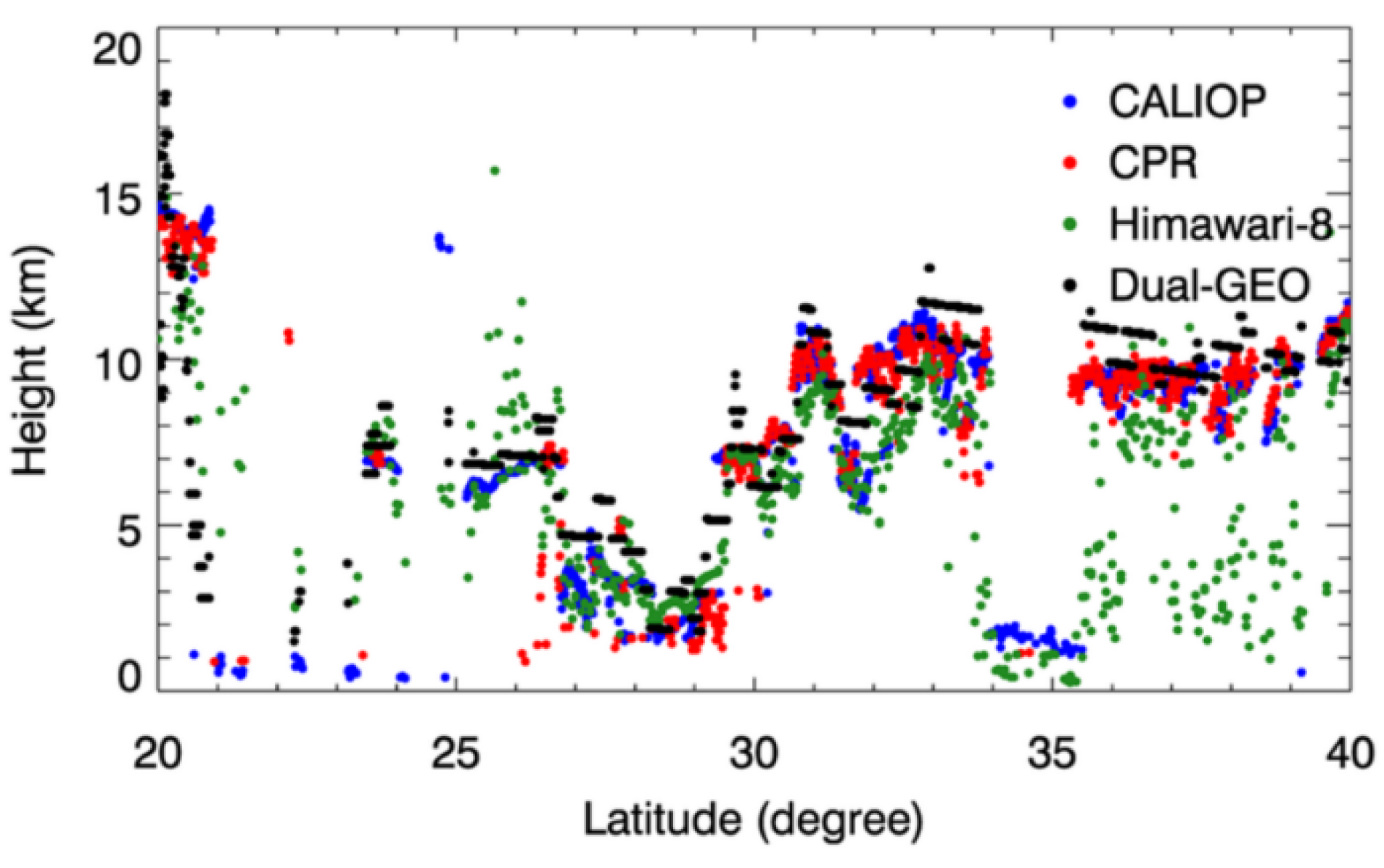
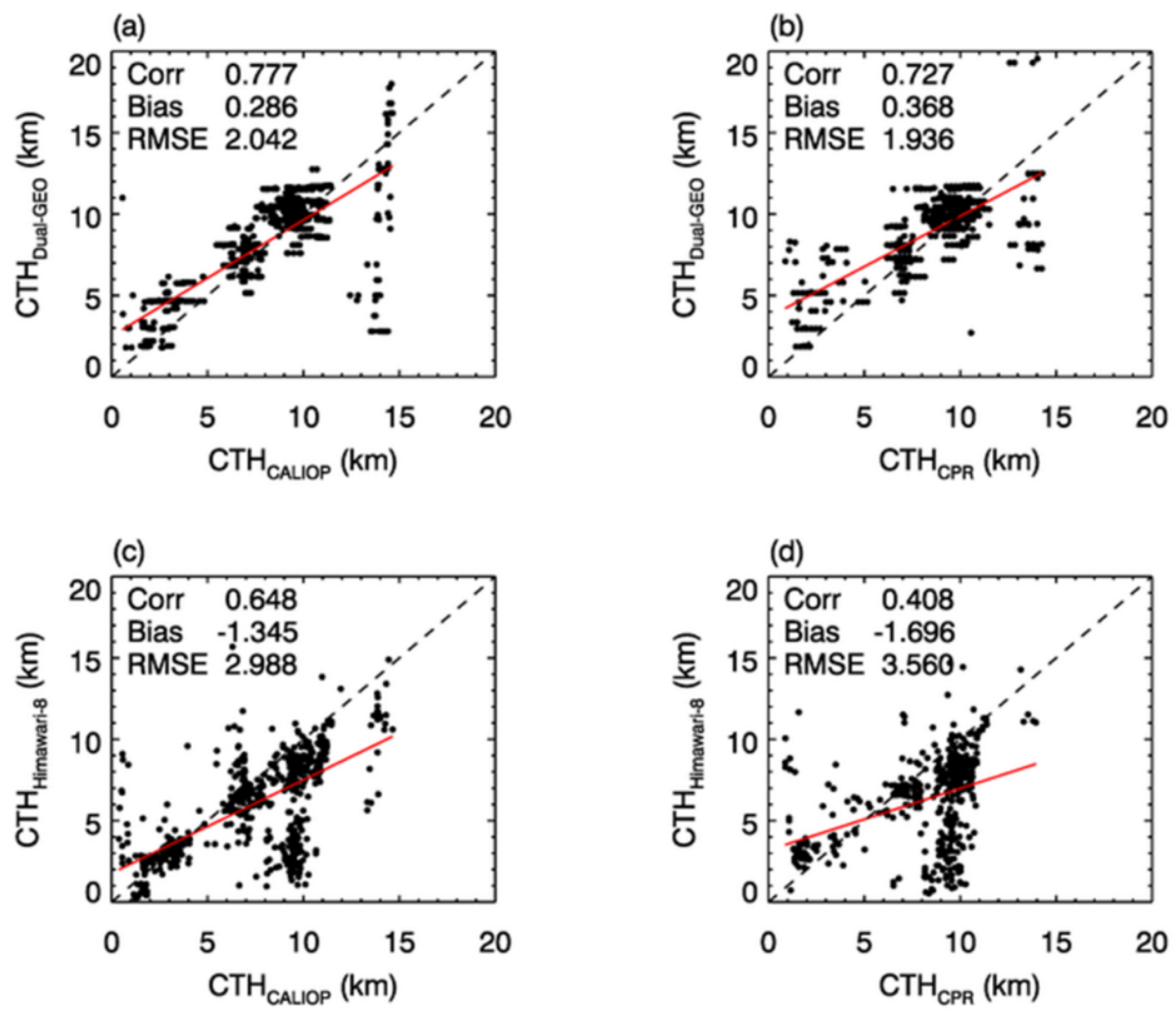
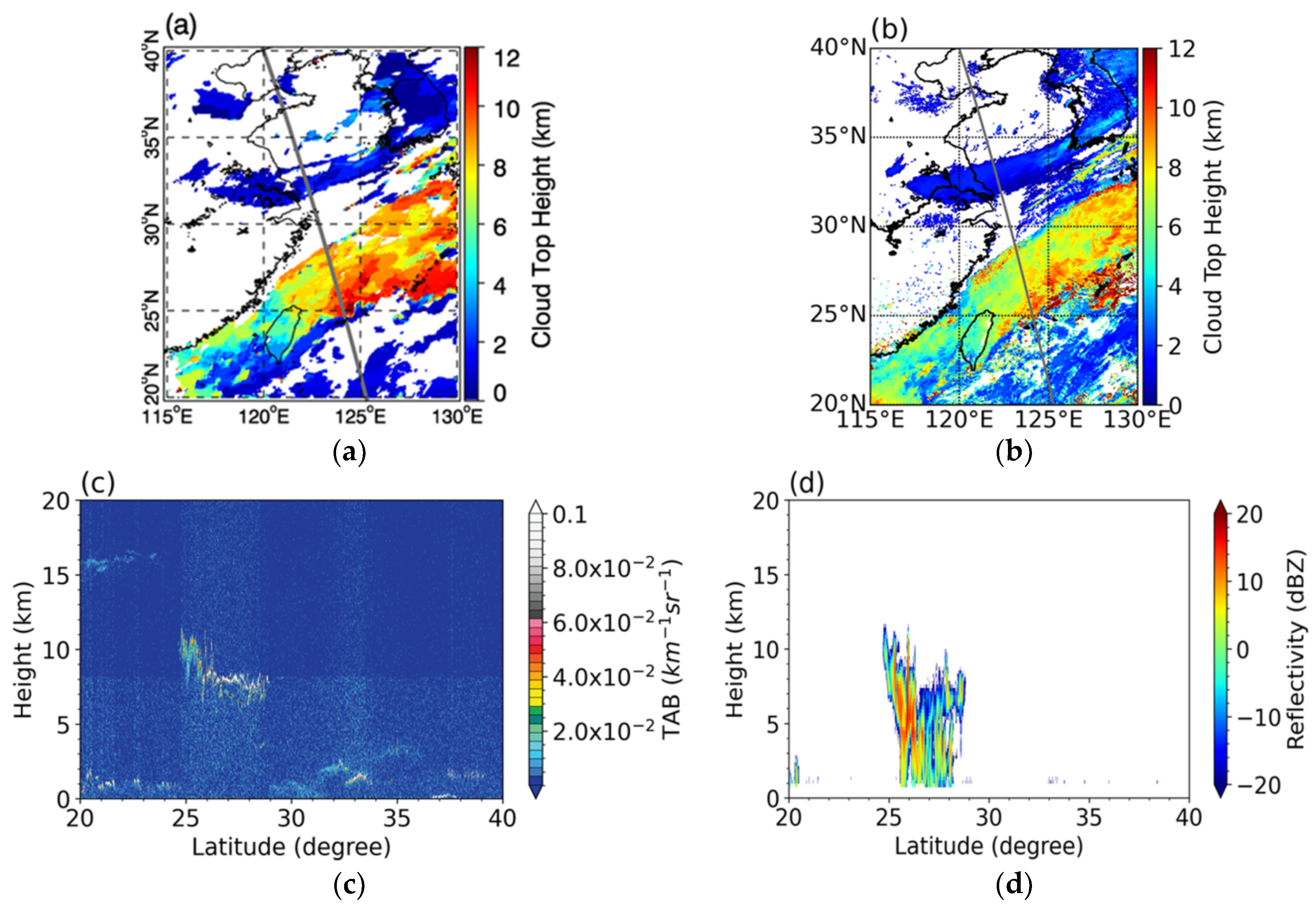
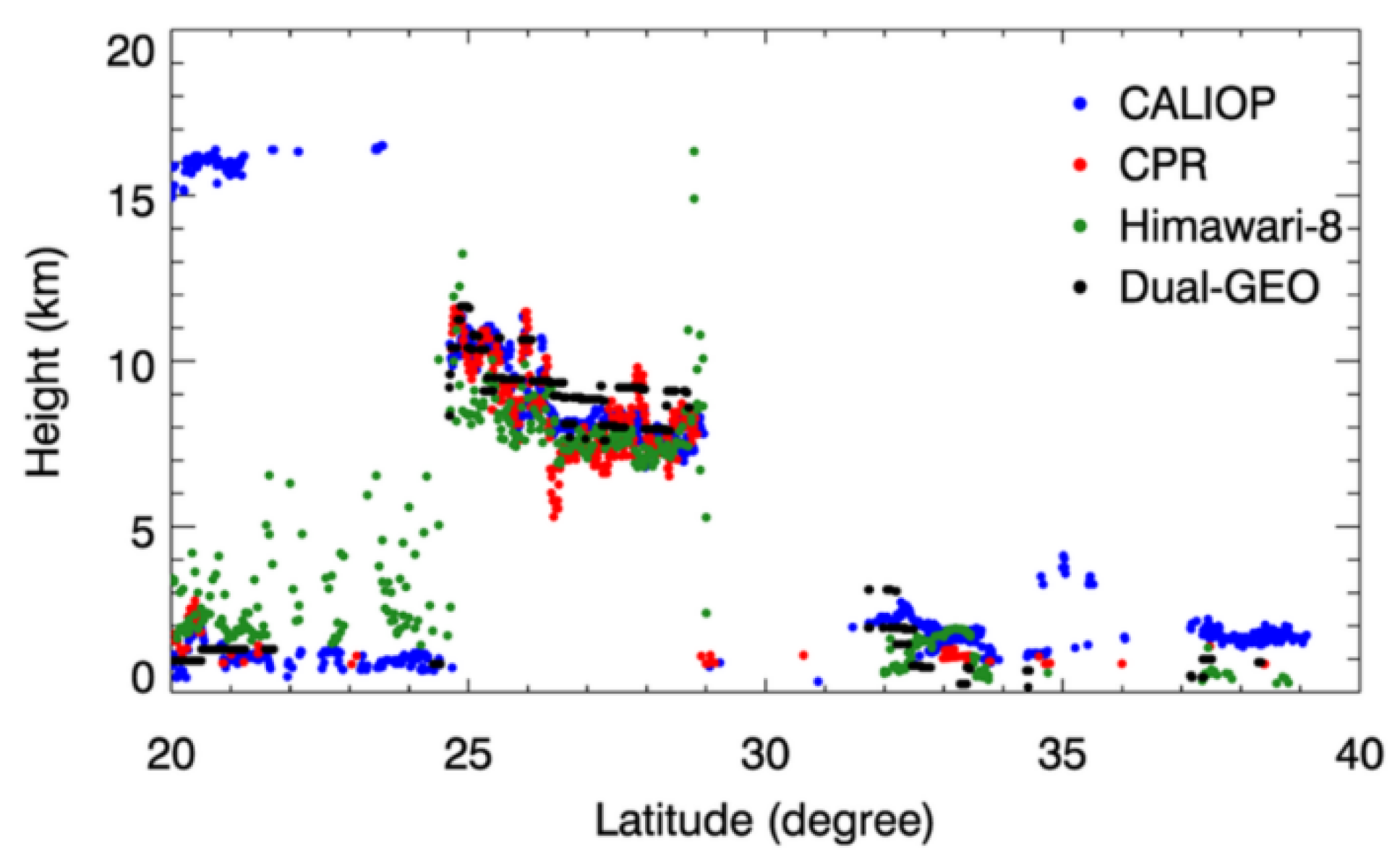

| Channel Number | Channel | AHI Central Wavelength (µm) | Spatial Resolution (km) | S-VISSR Wavelength Range (µm) | Spatial Resolution (km) |
|---|---|---|---|---|---|
| 1 | Visible | 0.47 | 1.0 | ||
| 2 | 0.51 | 1.0 | |||
| 3 | 0.64 | 0.5 | 0.55–0.90 | 1.25 | |
| 4 | Near-Infrared | 0.86 | 1.0 | ||
| 5 | 1.6 | 2.0 | |||
| 6 | 2.3 | 2.0 | |||
| 7 | Infrared | 3.9 | 2.0 | 3.5–4.0 | 5.0 |
| 8 | 6.2 | 2.0 | |||
| 9 | 6.9 | 2.0 | 6.3–7.6 | 5.0 | |
| 10 | 7.3 | 2.0 | |||
| 11 | 8.6 | 2.0 | |||
| 12 | 9.6 | 2.0 | |||
| 13 | 10.4 | 2.0 | 10.3–11.3 | 5.0 | |
| 14 | 11.2 | 2.0 | |||
| 15 | 12.4 | 2.0 | 11.5–12.5 | 5.0 | |
| 16 | 13.3 | 2.0 |
| Satellite/Instrument | Product Name | Product Version | Variable Name |
|---|---|---|---|
| CALIPSO 1/CALIOP 2 | CAL_LID_L1 | 4.10 | Total_Attenuated_Backscatter_532 |
| CAL_LID_L2_01kmCLay | 4.20 | Layer_Top_Altitude | |
| CloudSat/CPR 3 | 2B-GEOPROF | 4.0 | CPR_Cloud_Mask |
| Himawari-8/AHI 4 | L2CLP010 | 1.0 | CLTH |
| Parameter | Value |
|---|---|
| Normalized cross-correlation (NCC) threshold | 0.5 |
| Template image size | 35 × 35 |
| Source image size | 69 × 69 |
| Maximum allowed horizontal shift | 17 |
| Maximum allowed vertical shift | 17 |
| Satellite (longitude) | FY-2E (86.5°E) | FY-2G (104.5°E) | FY-4A (104.7°E) | FY-2F (112.0°E) | GK-2A (128.2°E) | Himawari-8 (140.7°E) |
|---|---|---|---|---|---|---|
| FY-2E (86.5°E) | - | 2.713 (0.369) | 2.683 (0.373) | 1.923 (0.520) | 1.192 (0.839) | 0.932 (1.073) |
| FY-2G (104.5°E) | - | 243.149 (0.004) | 6.49 (0.154) | 2.07 (0.484) | 1.37 (0.732) | |
| FY-4A (104.7°E) | - | 6.67 (0.150) | 1.04 (0.480) | 0.69 (0.728) | ||
| FY-2F (112.0°E) | - | 3.01 (0.332) | 1.71(0.584) | |||
| GK-2A (128.2°E) | - | 1.95 (0.257) | ||||
| Himawari-8 (140.7°E) | - |
© 2020 by the authors. Licensee MDPI, Basel, Switzerland. This article is an open access article distributed under the terms and conditions of the Creative Commons Attribution (CC BY) license (http://creativecommons.org/licenses/by/4.0/).
Share and Cite
Lee, J.; Shin, D.-B.; Chung, C.-Y.; Kim, J. A Cloud Top-Height Retrieval Algorithm Using Simultaneous Observations from the Himawari-8 and FY-2E Satellites. Remote Sens. 2020, 12, 1953. https://doi.org/10.3390/rs12121953
Lee J, Shin D-B, Chung C-Y, Kim J. A Cloud Top-Height Retrieval Algorithm Using Simultaneous Observations from the Himawari-8 and FY-2E Satellites. Remote Sensing. 2020; 12(12):1953. https://doi.org/10.3390/rs12121953
Chicago/Turabian StyleLee, Jonghyuk, Dong-Bin Shin, Chu-Yong Chung, and JaeGwan Kim. 2020. "A Cloud Top-Height Retrieval Algorithm Using Simultaneous Observations from the Himawari-8 and FY-2E Satellites" Remote Sensing 12, no. 12: 1953. https://doi.org/10.3390/rs12121953





